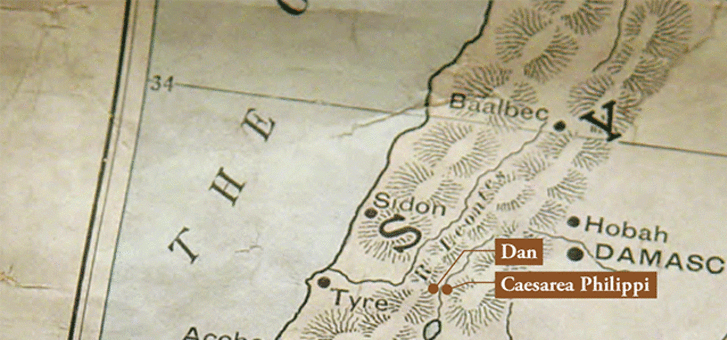In the September 2014 issue of SIGNS OF THE TIMES, the editors unintentionally introduced a typographic error into Pastor Peter Roennfeldt's article. We would like to issue a sincere apology to Pastor Roennfeldt for the mistake. The following is how the article should read:
Long before I ever visited the two ancient cities, I was familiar with the idiom “from Dan to Beersheba,” which meant from one geographic extremity to another and everything in between.
The ancient Israelite location of Dan is the well-watered area below Mount Herman in the north of Israel, while the city of Beersheba sits in the dry, harsh Negev desert to the south. The territory in between—and nine times in the Old Testament described as “from Dan to Beersheba”—was settled by the 12 Hebrew or Israelite tribes at the end of the exodus. Following World War I, these ancient boundaries were framed by the League of Nations’ mandate as the territory of Palestine.
The cities of Dan, and Banias nearby, were at the head of two main tributaries of the Jordan River, both surrounded by fertile fields and lush vegetation, watered by fresh water springs fed by snowmelt from the mountains behind. Dan features in the Old Testament, Banias (now known as Caesarea Philippi) in the New. And both are great archaeological sites and of great interest to students of the Bible.
![]() The Ancient City of Dan
The Ancient City of Dan
When the 12 tribes of Israel first set foot on the Promised Land just north of the Dead Sea, it wasn’t the relatively barren land it is today. It was lush and quite densely inhabited. So they had to fight to gain possession of the land promised to their forefathers. One tribe, Dan, took a city from the Canaanites, giving it its name today.
Thousands of archaeological artefacts have since been unearthed, including the oldest intact arch, a Canaanite mud-brick city gateway, which is almost 4000 years old.
Also found was an altar complex from the days of King Jeroboam, the first king of the northern Israelite Kingdom of Israel after the revolt of the 10 northern Israelite tribes.
Jeroboam feared that if the people of these 10 tribes were to go to Jerusalem to worship, they might well “revert to the house of David” (their old allegiance), so he erected altars for worship at Bethel and Dan (1 Kings 12:26, 29) to keep them within his boundaries. This remained a cultic site into the Hellenistic period, with the complex at Dan still attracting many curious visitors today.
While the story of the split within the Israelite tribes is found in the Bible, in 1993, fragments of a basalt stone inscribed with a victory text from the late ninth-century BC were found within the walls of the outer city gates of Dan. The author, perhaps a king from Damascus, just over 100 kilometres away, tells of conflict with the kings of Israel and the house of David (a reference to the dynasty of David and a term frequently used in the Bible). This is a significant discovery as it is the earliest textual reference to King David found outside of the Bible.
![]() Caesarea Philippi
Caesarea Philippi
Caesarea Philippi was first settled in Greek times, with the town built around the spring that feeds the Jordan, near a grotto and shrines dedicated to Pan, the Greek god for desolate places. Because of this, it was also called Paneas and Banias.
About 50 years before Jesus visited, Herod the Great built a temple of white marble at the grotto. After his death, his son, Herod Philip II (or Philip the Tetrarch), built a city on the site. In AD 14, he named the city Caesarea Philippi, in honour of himself and the Emperor Caesar Augustus.
While living within the borders of ancient biblical Israel, the people of Caesarea Philippi were predominantly Gentile (non-Jews) who honoured the Roman emperor, and who had a history of pagan worship.
A Startling Revelation
The Gospel accounts do not tell us that Jesus went right into Caesarea Philippi. Neither is there any record of Jesus ever visiting Dan, but late in His ministry, He did go “on to the villages around Caesarea Philippi” (Mark 8:27, underline added). Whether these included Dan, just six kilometres to the west, we don’t know, but it was during His visit to this region that Jesus first confirmed His real identity to His disciples.
In this isolated region of sparse villages, far from the Jewish heartland, Jesus asked His disciples, “Who do the crowds say I am?” (Luke 9:18). The disciple Peter answered, “You are the Messiah, the Son of the living God” (Matthew 16:16).
So ironically, while the Roman emperor was honoured in nearby temples as a son of god, Jesus accepted Peter’s declaration that He was the “Son of the living God,” testifying that this was revealed to Him “by my Father in heaven” (verse 17).
Jesus’ metaphors and allusions suggest He was familiar with the region’s features. In contrast to the rocks upon which pagan temples had been built, Jesus declared, “On this rock [not meaning Peter] I will build my church, and the gates of Hades will not overcome it” (verse 18).
Were the temples and Pan’s grotto symbolic of all that would come against His church? Did the cave in which sacrifices were offered to appease pagan deities represent the gates of evil? This was the first time Jesus used the word 'church', adding, “I will give you the keys of the kingdom of heaven . . . then he ordered his disciples not to tell anyone that he was the Messiah” (verses 19, 20).
A Different Plan
For thousands of years, the Jews had been waiting for the Messiah, a deliverer. With Jesus confirming His identity, they assumed He would therefore deliver them from Roman oppression, restoring dignity to the Jewish kingdom. He would feed armies, remove physical barriers, heal the wounded and raise those killed!
But Jesus’ plan was in stark contrast to their expectations and He quickly dashed their hopes. Yes, He would go up to Jerusalem—but not for military conquest. His kingdom was of an entirely different nature to the Roman Empire or Jewish expectations.
Matthew records, “Jesus began to explain to his disciples that he must go to Jerusalem and suffer many things at the hands of the elders, the chief priests and the teachers of the law, and that he must be killed and on the third day be raised to life” (verse 21).
The disciples were deeply shocked. “ ‘Never, Lord!’ [Peter] said. ‘This shall never happen to you!’ Jesus turned and said to Peter, ‘Get behind me, Satan! You are a stumbling block to me; you do not have in mind the concerns of God, but merely human concerns’ ” (verses 22, 23).
Caesarea Philippi represented the things of this world. The city had been built and named to honour an emperor and a king, with shrines and temples erected to them and gods of their own creation. It was part of a harsh kingdom of hierarchies, status and power.
In contrast, Jesus represented the things of God—sacrifice for others, a kingdom of status reversal and the power of love.
Jesus needed those days in the region of Caesarea Philippi, away from the crowds pressing Him to establish an earthly Jewish kingdom. This Gentile region had little allegiance to Jerusalem. Its retreats beside the springs and rivers, and the isolation of the hills beyond, provided the perfect environment to clarify His plan of a heavenly kingdom, teach His disciples and to work for His Father’s glory.




